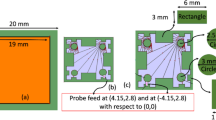Abstract
A RCS prediction system named SCTE (Scattering from Complex Target and Environment) for calculating high-frequency electromagnetic scattering from complex target within complex environment is presented. The scattering body is described by Computer-Aided-Design (CAD) representations in which the complex body is modeled as NURBS (Non-Uniform Rational B-spline) surfaces. The complex environment (rough surface of sea or ground) is also carefully considered by using fractal function. Scattering fields are calculated by using physical optics and the equivalent currents methods. There is a good agreement between the present results and that from measurements which demonstrates the accuracy of this system.
Similar content being viewed by others
References
Crispin J M, Siegel K M.Methods for Radar Cross Section Analysis[M]. New York: Academic Press, 1968.
Rius J M, Ferrando M, Jofre L. GRECO: graphical electromagnetic computing for RCS prediction in realtime[J].IEEE Antennas, and Propagation Magazine, 1993,35(2): 7–17.
Newman W M, Sprovil R F.Principle of Interactive Computer Graphics [M]. London: Mc Graw-Hill, 1979.
Cao Qin-feng, Zhu Guo-qiang, Xu Penggen. Computation for the RCS of complex bodies using method of improved sub-object division[C].Proceedings of Asia-Pacific Conference on Environmental Electromagnetics, Xi’an, 1996. 99–103.
Knott E F. RCS reduction of dihedral corners [J].IEEE Trans,AP-25: 406–407.
Zhu Guo-qiang, Cao Qin-feng, Yang He-lin. Analysis of double bounce scattering between target and rough surface[J].Chinese Journal of Radio Science, 1997,11: 79–84 (Ch).
Zhu Guo-qiang. Investigation of the composite scattering by the targets and rough surfaces. [Doctor dissertation]. Wuhan: Wuhan University of China, 1997.
Yang He-lin, Zhu Guo-qiang, Cao Qing-feng,et al. Analysis of double bounce scattering btween plate and a two dimension composite surface[C].Proceedings of China-Japan Joint Meeting On Microwaves (CJMW’96). Anhui Hefei: Chinese Science and Techniquell university press, 1996. 146–150(Ch).
Author information
Authors and Affiliations
Additional information
Foundation item: Supported by the National Natural Science Foundation of China
Biography: CAO Qin-feng (1972-) male, Ph.D. candidate.
Rights and permissions
About this article
Cite this article
Qin-feng, C., Shu, L. & Peng-gen, X. SCTE: RCS prediction system for complex target and interaction with environment. Wuhan Univ. J. Nat. Sci. 4, 299–303 (1999). https://doi.org/10.1007/BF02842355
Received:
Issue Date:
DOI: https://doi.org/10.1007/BF02842355




